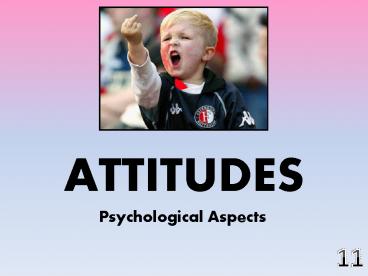ATTITUDES - PowerPoint PPT Presentation
1 / 10
Title:
ATTITUDES
Description:
ATTITUDES Psychological Aspects LEARNING OUTCOMES Definitions and components of attitudes Influences on formation of an attitude and influences on behaviour Changing ... – PowerPoint PPT presentation
Number of Views:1205
Avg rating:3.0/5.0
Title: ATTITUDES
1
ATTITUDES
- Psychological Aspects
11
2
LEARNING OUTCOMES
- Definitions and components of attitudes
- Influences on formation of an attitude and
influences on behaviour - Changing attitudes through cognitive dissonance
and persuasive communication
3
(No Transcript)
4
ATTITUDES
- An attitude is a complex mix of feelings,
beliefs and values that predisposes somebody to
behave towards something or someone in a
consistent way. - Attitudes are used to explain a pattern of
behaviour or a response in a given situation. - An enduring emotional behavioural response,
although it can be established firmly, an
attitude is unstable can be changed
controlled.
5
ATTITUDES
- Attitudes are directed towards ATTITUDE OBJECTS,
which can be PLACES, SITUATIONS the BEHAVIOUR
of other people. - Eg. A player dislikes training. The attitude
object is the training the player may adopt a
negative attitude towards training.
6
How attitudes are formed.....
- Formed by experience and learning. This can be
influenced by a number of factors.
PEER GROUPS Friendship groups and wider peer
groups strongly influence an individuals
attitude. An acceptance of the groups attitudes
towards an attitude object is a way of gaining
membership of a group and gaining a sense of
identity. A team that has a shared set of
attitudes will show a high degree of cohesion.
CONDITIONING Rewards will strengthen existing
attitudes. A performer who is praised for
training will have their attitude towards
training strengthened, which in turn will
strengthen the intention to train and therefore
the likelihood of training.
7
SOCIALISATION AND SOCIAL LEARNING We learn a lot
from significant others parents, teachers,
coaches, wider role models and the media and
they are powerful formers of attitudes, including
negative ones that may lead to prejudice and
stereotyping.
FAMILIARITY The more a person experiences an
attitude object, the more likely a person is to
develop a positive attitude towards it. For
example the more often a child is taken to a
sports club or to matches by their parents, the
more likely the child is to develop a positive
attitude towards that sport and to take it up
themselves.
8
Positive attitudes are formed by belief in
exercise enjoyable experiences in sport being
good at a particular sport being excited by the
challenge of sport using sport as a stress
release the influence of others where
participation is the norm
Negative attitudes are formed by not believing
in the benefits of exercise a bad past
experience injury a lack of ability fear of
taking part suffering stress when taking part the
influence of others when non-participation is the
norm
9
COMPONENTS OF ATTITUDES
- According to the Triadic model, attitudes have
three elements (components). - THE COGNITIVE COMPONENT - what we know and
believe about the attitude object - THE AFFECTIVE COMPONENT - how we feel about the
attitude object - THE BEHAVIOURAL COMPONENT how we behave
towards, respond to or intend to respond to the
attitude object.
10
EXAM STYLE QUESTION
- Most elite performers have positive attitudes to
their preparation and performance. - What is meant by the term attitude and how
might an elite performer have developed such a
positive attitude? - (4 marks)
- b. Using an example from sport and with reference
to the triadic model, discuss how a negative
attitude could be altered. - (3 marks)































